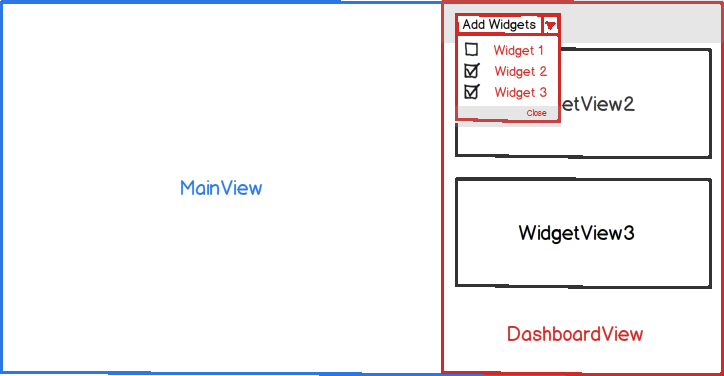I am building a Flex 4 based application using the presentation model design pattern. This application will have several different components to it as shown in the image below.

The MainView and DashboardView will always be visible and they each have corresponding presentation models and models as necessary. These views are easily created by declaring their MXML in the application root.
<s:HGroup width="100%" height="100%">
<MainView width="75% height="100%"/>
<DashboardView width="25%" height="100%"/>
</s:HGroup>
There will also be many WidgetViewN views that can be added to the DashboardView by the user at runtime through a simple drop down list. This will need to be accomplished via ActionScript.
The drop down list should always show what WidgetViewN has already been added to the DashboardView. Therefore some state about which WidgetViewN's have been created needs to be stored. Since the list of available WidgetViewN and which ones are added to the DashboardView also need to be accessible from other components in the system I think this needs to be stored in a Model object.
My understanding of the presentation model design pattern is that the view is very lean. It contains as close to zero logic as is practical. The view communicates/binds to the presentation model which contains all the necessary view logic. The presentation model is effectively an abstract representation of the view which supports low coupling and eases testability. The presentation model may have one or more models injected in in order to display the necessary information. The models themselves contain no view logic whatsoever.
So I have a several questions around this design.
- Who should be responsible for creating the WidgetViewN components and adding these to the DashboardView? Is this the responsibility of the DashboardView, DashboardPresentationModel, DashboardModel or something else entirely? It seems like the DashboardPresentationModel would be responsible for creating/adding/removing any child views from it's display but how do you do this without passing in the DashboardView to the DashboardPresentationModel?
- The list of available and visible WidgetViewN components needs to be accessible to a few other components as well. Is it okay for a reference to a WidgetViewN to be stored/referenced in a model?
- Are there any good examples of the presentation model pattern online in Flex that also include creating child views at runtime?
